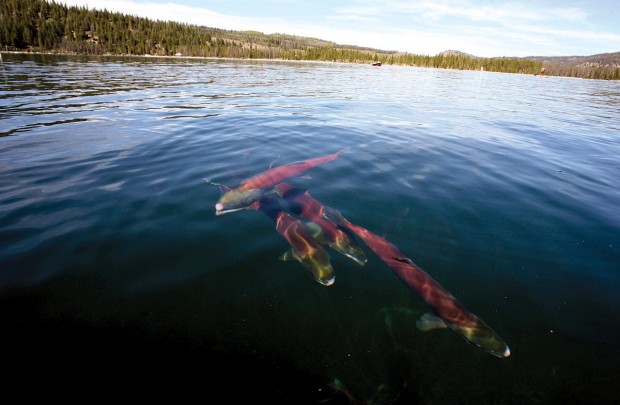forum
library
tutorial
contact

Conference Discusses History and Future
of Sawtooth National Recreation Area
by Rachel Cohen
Boise State Public Radio, May 25, 2022
|
the film forum library tutorial contact |

|
Conference Discusses History and Future
by Rachel Cohen
|
"I always turn to those iconic anadromous fish species that
created this ecosystem over the past several millennia,"
-- Daniel Stone, a policy analyst for the Shoshone-Bannock Tribes
 The Sawtooth National Recreation Area is turning 50 this August. A Boise State University conference Tuesday focused on the history of this iconic Idaho destination, formed by a bipartisan act of Congress, and the challenges it faces ahead.
The Sawtooth National Recreation Area is turning 50 this August. A Boise State University conference Tuesday focused on the history of this iconic Idaho destination, formed by a bipartisan act of Congress, and the challenges it faces ahead.
Kirk Flannigan is the area ranger for the SNRA. He told the Andrus Center for Public Policy conference attendees that overall visits to the recreation area increased by 85% from 2015 to 2020.
In 2020, recreation in the SNRA was especially popular, with nearly 800,000 visits in the summer and fall. Those numbers were produced by a survey conducted every five years.
That increase led to some negative impacts on the landscape -- like hundreds of campfires that were left unattended -- and prompted the Forest Service to institute 10-day-stay limits for campers and a bear-resistant food-storage order the following summer.
Flannigan said Tuesday he's especially worried about the pressures on a few high-traffic trails and wilderness spots. It might lead the Forest Service to consider some limits on access.
"I know people are going to hate this, but we need to think about direct management practices, such as a permit or a fee," he said.
The SNRA does not currently have entrance permits or fees, but a user fee system was in place for several years starting in the 1990s.
Other panelists at the day-long conference listed climate change, wildfire and development pressure as top challenges for the recreation area in its next 50 years.
Several of the talks kept coming back to the two salmon species, Chinook and sockeye, that many speakers said are the heart of the area.
Daniel Stone, a policy analyst for the Shoshone-Bannock Tribes, said when he thinks about the SNRA, he thinks about salmon.
"I always turn to those iconic anadromous fish species that created this ecosystem over the past several millennia," he said.
Stone and other panelists said the main threats to the fish are outside the recreation area's boundaries: the four Lower Snake River Dams.
Sen. Ron Wyden, a Democrat from Oregon, was invited to the conference to speak about his "Recreation Not Red Tape Act." When asked whether he supported the breaching of the Lower Snake River Dams, he did not give a definitive answer.
"We either build a coalition to strike a balance, and we both protect our rivers, and our fish and our commerce," Wyden said, "or we decide we're not going to do a balanced approach and you basically get a lawyers' full employment program."
Idaho Congressman Mike Simpson announced his proposal to remove the dams in 2021.
Politics on the state level could also pose challenges to the Sawtooth National Recreation Area, as evidenced by the Idaho House of Representatives shutting down a resolution to celebrate the area's 50th anniversary two times this past legislative session.
The Andrus Center of Public Policy at Boise State University will publish a policy white paper following up on the conference sometime later this year.
learn more on topics covered in the film
see the video
read the script
learn the songs
discussion forum
